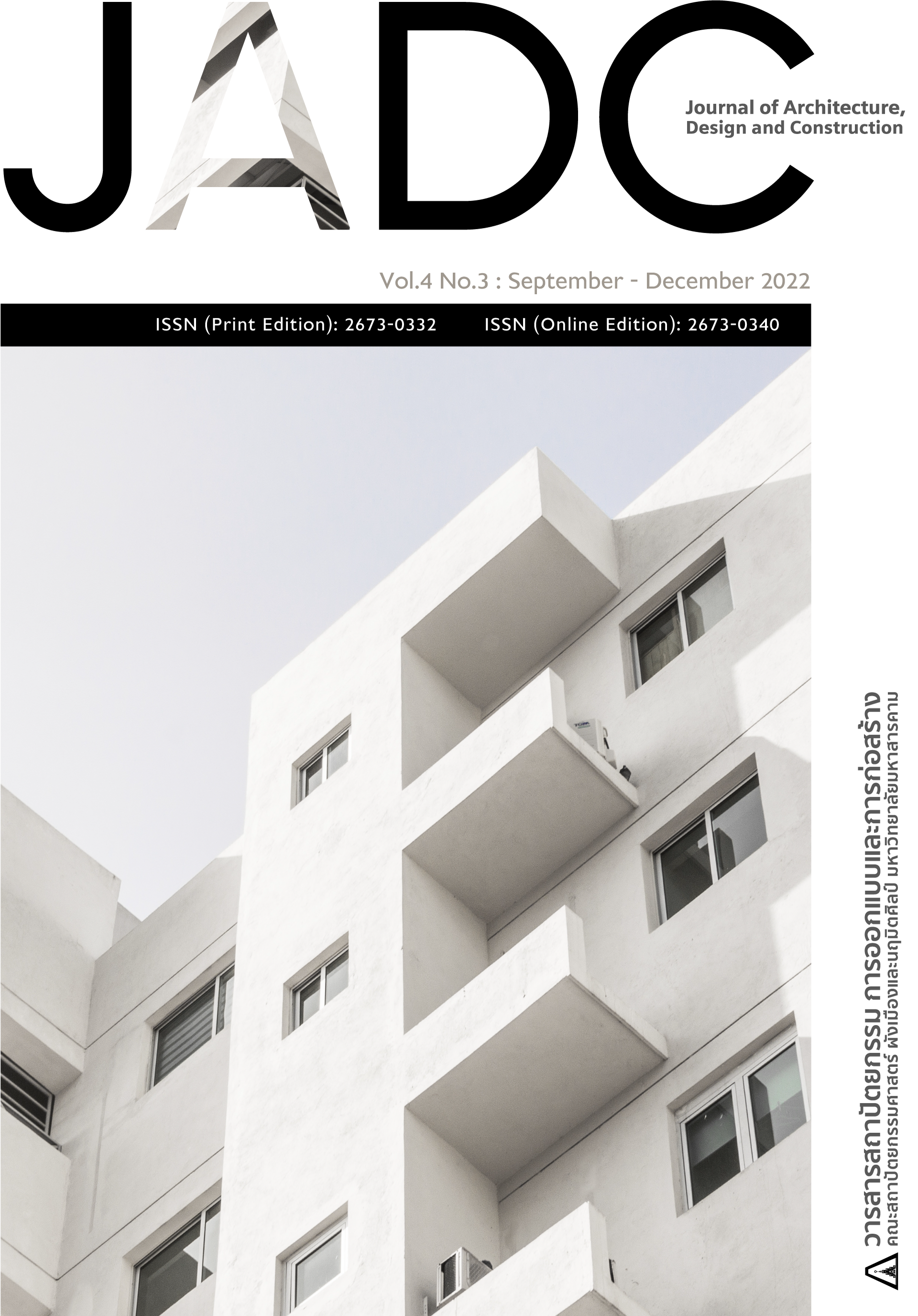แบบจำลองการประเมินทางเทคนิคโดยใช้วิธีกระบวนการวิเคราะห์เชิงลำดับชั้นแบบฟัซซี สำหรับการคัดเลือกผู้รับเหมาในโครงการก่อสร้าง
Main Article Content
บทคัดย่อ
งานวิจัยนี้มีวัตถุประสงค์เพื่อพัฒนาแบบจำลองการประเมินด้านเทคนิคผู้รับเหมาในโครงการก่อสร้าง ด้วยวิธีกระบวนการลำดับชั้นเชิงวิเคราะห์แบบฟัซซี มาเป็นเครื่องมือในการกำหนดค่าน้ำหนักแต่ละเกณฑ์ปัจจัย ด้วยการวินิจฉัยเปรียบเทียบทางเลือกในการประเมินด้านเทคนิคผู้รับเหมาในโครงการก่อสร้าง โดยอาศัยการตัดสินใจเป็นหมู่คณะจากผู้เชี่ยวชาญจำนวน 8 ท่าน ได้แก่บริษัทเจ้าของโครงการ 2 ท่าน บริษัทที่ปรึกษาและควบคุมงานก่อสร้าง 2 ท่าน บริษัทปรึกษาด้านสำรวจปริมาณ 2 ท่าน และบริษัทรับเหมาก่อสร้าง 2 ท่าน มาเป็นข้อมูลในการพัฒนาแบบจำลองการประเมินโดยกำหนดเกณฑ์ปัจจัยเป็นลักษณะแผนภูมิระดับชั้น จากนั้นผู้เชี่ยวชาญให้คะแนนเป็นรายคู่ คำนวนหาค่าน้ำหนักความสำคัญของปัจจัยหลัก 5 ด้าน ได้แก่ ด้านการควบคุมโครงการ มีปัจจัยรอง 5 ปัจจัย (รายคู่เปรียบเทียบจำนวน 10 รายคู่) ด้านทรัพยากรบุคคล มีปัจจัยรอง 3 ปัจจัย (รายคู่เปรียบเทียบจำนวน 3 รายคู่) ด้านการจัดซื้อวัสดุหลัก มีปัจจัยรอง 2 ปัจจัย (รายคู่เปรียบเทียบจำนวน 1 รายคู่) ด้านเครื่องมือ-เครื่องจักร มีปัจจัยรอง 3 ปัจจัย (รายคู่เปรียบเทียบจำนวน 3 รายคู่) และด้านความปลอดภัยและสิ่งแวดล้อม มีปัจจัยรอง 3 ปัจจัย (รายคู่เปรียบเทียบจำนวน 3 รายคู่) ทั้งสิ้น 20 รายคู่ ลงในแบบจำลอง พบว่าค่าน้ำหนักปัจจัยหลัก ด้านการควบคุมโครงการ 0.39 ด้านทรัพยากรบุคคล 0.22 ด้านการจัดซื้อวัสดุหลัก 0.07 ด้านเครื่องมือ-เครื่องจักร 0.23 และด้านความปลอดภัยและสิ่งแวดล้อม 0.09 ในการศึกษานี้ได้กำหนดสถานการณ์ประเมินด้านเทคนิคผู้รับเหมาจากโครงการก่อสร้าง จำนวน 4 โครงการ โดยนำผลคะแนนที่ได้จากแบบจำลองไปใช้ในการพิจารณาคัดเลือกผู้ชนะ ซึ่งเป็นการเปรียบเทียบลำดับผู้ชนะคัดเลือกจากแบบจำลองกับลำดับผู้ชนะคัดเลือกจริง ผลการศึกษา พบว่า โครงการที่ 1 โครงการที่ 2 และโครงการที่ 3 ลำดับผู้ชนะคัดเลือกตรงกับที่ทางเจ้าของโครงการคัดเลือกไว้ แต่โครงการที่ 4 ลำดับผู้ชนะคัดเลือกที่ทางเจ้าของโครงการเลือกไว้เปลี่ยนจากผู้รับเหมาราย N เป็นผู้รับเหมาราย P เนื่องจากผลการประเมินจากแบบจำลองผู้รับเหมาราย P มีคะแนนรวมด้านเทคนิคที่สูงกว่าผู้รับเหมาราย N แสดงให้เห็นว่า แบบจำลองที่นำมาใช้ประเมินมีรายละเอียดที่ชัดเจน ครอบคลุมที่มากขึ้นกว่าเดิม และสอดคล้องกับผลการประเมินของเจ้าของโครงการ
Downloads
Article Details

อนุญาตภายใต้เงื่อนไข Creative Commons Attribution-NonCommercial-NoDerivatives 4.0 International License.
บทความที่ได้รับการตีพิมพ์เป็นลิขสิทธิ์ของวารสารสถาปัตยกรรม การออกแบบและการก่อสร้าง คณะสถาปัตยกรรมศาสตร์ ผังเมืองและนฤมิตศิลป์ มหาวิทยาลัยมหาสารคาม
เอกสารอ้างอิง
ธนกฤต อรัญดร และอรกมล วังอภิสิทธิ์. (2563). การจัดลำดับความสำคัญของโครงการลงทุนก่อสร้างและปรับปรุงถนนในจังหวัดสงขลา. วารสารวิชาการ
วิศวกรรมศาสตร์ ม.อบ., 14(1), 115-128.
นิธิเดช คูหาทองสัมฤทธิ. (2562).การประยุกต์ระบบตรรกศาสตร์คลุมเครือในการประเมินความเสี่ยง สำหรับการเลือกเส้นทางการขนส่งต่อเนื่องหลายรูปแบบที่เหมาะ
สม. วารสารวิจัยและพัฒนา มจธ., 42(4), 353-373.
วัชรินทร์ ขวัญซ้าย และไพจิตร ผาวัน. (2562). การตัดสินใจเลือกแบบหล่อคอนกรีตในงานก่อสร้างอาคารสูงด้วยกระบวนการลำดับชั้นเชิงวิเคราะห์. การประชุม
วิชาการวิศวกรรมโยธาแห่งชาติ ครั้งที่ 24., 10-12 กรกฎาคม 2562 จังหวัดอุดรธานี.
Abimbola, H. A., Bolanle, A. O., & Adebayo O. A. (2020). Performance analysis of fuzzy analytic hierarchy process multi-criteria decision
support models for contractor selection. Scientific African., 9, e00471.
Ahad, N., Shaghayegh, Y. & Hamid, A. (2016). Fuzzy AHP Model for Prequalification of Engineering Consultants in the Iranian Public
Procurement System. J. Constr. Eng. Manage., 10.1061/(ASCE)ME.1943-5479.0000489.
Chang DY. (1996). Applications of the extent analysis method on fuzzy AHP. European Journal of Operational Research., 1996;95(3)
–655.
Holt, G. D., Olomolaiye, P. O., & Harris, F. C. (1994). Factors influencing UK construction clients choice of contractor. Build. Environ.,
(2), 241–248.
Jaman, I. A., Margaret, W. E. (2012). The impact of contractors’ attributes on construction project success: A post construction evaluation.
International Journal of Project Management., 31 (2013) 313–322.
Kai, C. G., Hui, H. G., & Heap, -Y. C. (2018). Integration Model of Fuzzy AHP and Life-Cycle Cost Analysis for Evaluating Highway
Infrastructure Investment. J. Infrastruct. Syst., 10.1061/(ASCE)IS.1943-555X.0000473.
Mohammad, R. A., Yagub, A., Mohammad, H. S., & Weng, T. C. (2017). A type-2 fuzzy set model for contractor prequalification.
Automation in Construction., 84 (2017) 356–366.
Ossama, H., & Khaled, N. (2013). Prequalification of Egyptian construction contractors using fuzzy-AHP models. Engineering Construction
and Architectural Management., Vol. 20: 381-405.
Sharareh, K., Behzad, R., & Bac, D. (2019). Application of Delphi Method in Identifying, Ranking, and Weighting Project Complexity
Indicators for Construction Projects. J. Leg. Aff. Dispute Resolut. Eng. Constr., 10.1061/(ASCE)LA.1943-4170.0000338.


